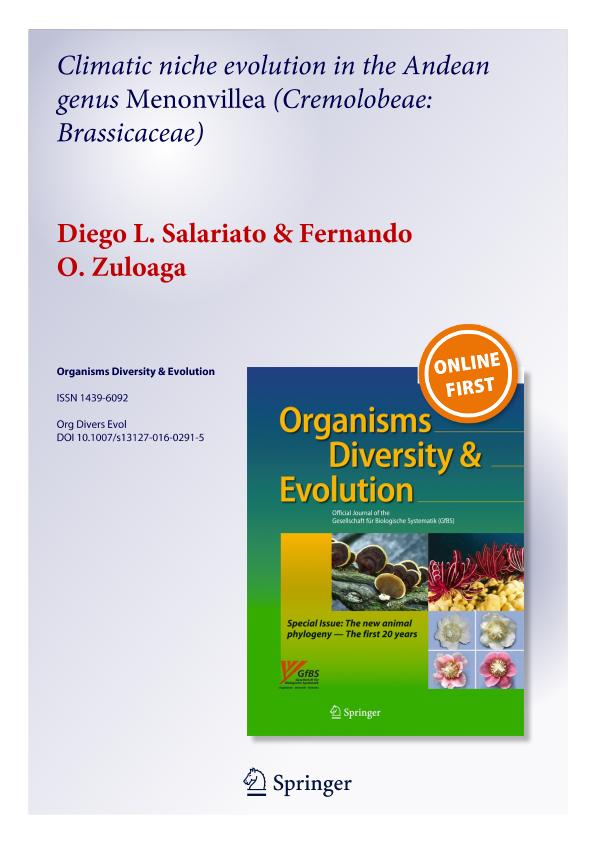Mostrar el registro sencillo del ítem
dc.contributor.author
Salariato, Diego Leonel

dc.contributor.author
Zuloaga, Fernando Omar

dc.date.available
2017-06-26T23:58:58Z
dc.date.issued
2017-03
dc.identifier.citation
Salariato, Diego Leonel; Zuloaga, Fernando Omar; Climatic niche evolution in the Andean genus Menonvillea (Cremolobeae: Brassicaceae); Springer Heidelberg; Organisms Diversity & Evolution; 17; 1; 3-2017; 11-28
dc.identifier.issn
1439-6092
dc.identifier.uri
http://hdl.handle.net/11336/18979
dc.description.abstract
The study of how climatic niches change over evolutionary time has recently attracted the interest of many researchers. Different methodologies have been employed principally to analyze the temporal dynamics of the niche and specially to test for the presence of phylogenetic niche conservatism. Menonvillea, a genus of Brassicaceae including 24 species, is distributed primarily along the Andes of Argentina and Chile, with some taxa growing in southern Patagonia and others in the Atacama Desert and the Chilean Matorral. The genus is highly diversified morphologically but also presents a remarkably wide ecological range, growing from the high Andean elevations, to the dry coastal deserts in Chile, or the Patagonia Steppe in Argentina. In this study, we used molecular phylogenies together with climatic data to study climatic niche evolution in the genus. The results show that the main climatic niche shifts in Menonvillea occurred between the sections Cuneata-Scapigera and sect. Menonvillea throughout the Mid-Late Miocene, and associated with the two main geographical distribution centers of the genus: the highlands of the central-southern Andes and the Atacama Desert-Chilean Matorral, respectively. Climatic niches in these lineages were mainly differentiated by the aridity and potential evapotranspiration, the minimum temperatures of the coldest month, and the temperature annual range and seasonality. Niche evolution in Menonvillea deviated from a Brownian motion process, with most of the climatic dimension best-fitting to an Ornstein-Uhlenbeck model of multiple adaptive peaks. Our results also indicated that higher aridity levels and lower annual temperature ranges were associated with the evolution of the annual habit, as exemplified by the distribution of sect. Menonvillea. Finally, the results suggested that climatic niche evolution in Menonvillea exhibited some degree of phylogenetic niche conservatism, fundamentally within the two main lineages (sect. Menonvillea and sects. Cuneata-Scapigera).
dc.format
application/pdf
dc.language.iso
eng
dc.publisher
Springer Heidelberg

dc.rights
info:eu-repo/semantics/openAccess
dc.rights.uri
https://creativecommons.org/licenses/by-nc-sa/2.5/ar/
dc.subject
Andes
dc.subject
Atacama Desert
dc.subject
Cruciferae
dc.subject
Patagonian Steppe
dc.subject
Phylogenetic Niche Conservatism
dc.subject
Species Distribution Modeling
dc.subject.classification
Ciencias de las Plantas, Botánica

dc.subject.classification
Ciencias Biológicas

dc.subject.classification
CIENCIAS NATURALES Y EXACTAS

dc.title
Climatic niche evolution in the Andean genus Menonvillea (Cremolobeae: Brassicaceae)
dc.type
info:eu-repo/semantics/article
dc.type
info:ar-repo/semantics/artículo
dc.type
info:eu-repo/semantics/publishedVersion
dc.date.updated
2017-06-26T21:35:10Z
dc.identifier.eissn
1618-1077
dc.journal.volume
17
dc.journal.number
1
dc.journal.pagination
11-28
dc.journal.pais
Alemania

dc.journal.ciudad
Heidelberg
dc.description.fil
Fil: Salariato, Diego Leonel. Consejo Nacional de Investigaciones Científicas y Técnicas. Instituto de Botánica Darwinion. Academia Nacional de Ciencias Exactas, Físicas y Naturales. Instituto de Botánica Darwinion; Argentina
dc.description.fil
Fil: Zuloaga, Fernando Omar. Consejo Nacional de Investigaciones Científicas y Técnicas. Instituto de Botánica Darwinion. Academia Nacional de Ciencias Exactas, Físicas y Naturales. Instituto de Botánica Darwinion; Argentina
dc.journal.title
Organisms Diversity & Evolution

dc.relation.alternativeid
info:eu-repo/semantics/altIdentifier/url/https://link.springer.com/article/10.1007/s13127-016-0291-5
dc.relation.alternativeid
info:eu-repo/semantics/altIdentifier/doi/http://dx.doi.org/10.1007/s13127-016-0291-5
Archivos asociados
